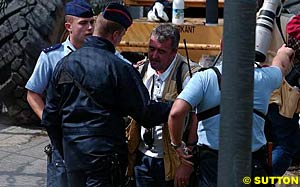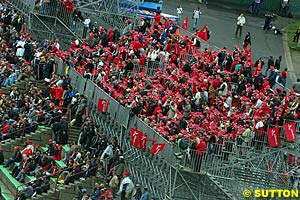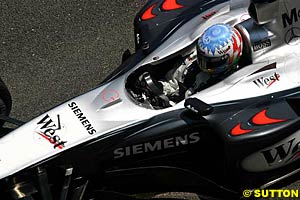Atlas F1 Magazine Writer
Fresh from the Formula One paddock
It was a Belgian journalist, representing a Brussels daily, who first ventured that Spa-Francorchamps could be off the calendar again after just one return. And, this, mind, was said on race day as he surveyed massive crowds packing grandstands opposite the 'old' pits, and those squashed into Eau Rouge's various permanent and temporary stands, through the windows of the split-level Media Centre.
It was also, crucially, said before the Media Centre became aware of manhandling of photographers at La Source by national police, an incident said by the FIA to be 'under investigation'.
Setting aside nationalistic differences – whilst the classic and picturesque circuit lies deep in Belgium's French-speaking region, there is little empathy between its Walloons and France, and the race's promoter, 38-year old Didier Defourny, is, despite basing himself in nearby Liege, French – after analysing, then investigating, the journalist's comments, it has to be said that he has a point or two.
For starters, on Friday, traffic jams around Liege, some 40 kilometres or so away from Spa, meant delays of over an hour. For sure, the race itself cannot be blamed for the deviations and road works in place, but, just a week previously, whilst en route to and from the nearby Rallye Deutschland, traffic had flowed at the corresponding times, implying that delays had been due to Grand Prix congestion and not road works.
Then, entering the circuit from Spa meant no less than three 'negotiations' with 'officials', none of whom were sure what various parking stickers entitled whom to. So, more chaos. At the coach park, for example, a tour operator with three buses, having paid the required €250 parking fee per vehicle, found his vehicles jammed in by coaches bearing no passes. When questioned, their drivers suggested, with nudges and winks, that the gate attendant had been 'paid'. When approached, the gate guard, who had previously communicated in reasonable English, feigned 'non-comprehendo'.
It all begs questions as to how numerous unauthorised coaches got past no less than four official control points before reaching the gate attendant, why routes in and out of the area differed on all three days? This confusion, however, provided forewarning of potential chaos before and after the race. Was it heeded? Was it just, as four hour jams proved only too well.
The coach operator's punters, though, were to experience still worse. Upon their arrival at Silver 1 Grandstand, which, they had been assured, gave panoramic views from numbered seats to the entry of Eau Rouge, they discovered the 'allocated' grand stand was not the Silver 1 depicted in brochures, but a temporary facility called Silver 1 which gave views only of the exit of the iconic corner.
But, having accepted their lot, imagine the fans' surprise when their numbered seats were occupied by strangers come Sunday. "No numbered seats today," was the convenient response given by ushers when questioned. When pushed, one admitted there were insufficient crowd marshals, resulting in 'free seating'. So, there were UK race fans treated to a view of only the exit of the most charismatic corner on Earth in exchange for €319 seat, a coach trip and four nights' hotel accommodation at exorbitant prices, for, incredibly, no big screen was visible from there either.
Another allegation was made by a group, which, having paid over €400 per seat opposite Ferrari's pits, enjoyed the sight on the first two days. On Sunday, though, their numbered seats faced Minardi. No, the black team had not been promoted to first in the Constructors' Championship; the grand stands had been magically renumbered overnight.
Paddock Club visitors were no better off. Imagine complying with, as laid-down in their host's information book, "normal rules of social etiquette in an international context", then being required to march through mud and slush and past overflowing toilets to sit on seats in driving rain of the type which caused cancellation of no less than 78 of Saturday's traditional 90 minute Practice (as occured in 2001, too). If Silverstone is, as described by powers-that-be, "a country fair at the end of muddy tracks", what then is Spa? Any wonder teams battle to give away passes for the place?
And, whilst on the subject of open stands, according to its official brochure, Spa has, despite being situated in brooding, rain-sodden forests, no less than 15 'public' grand stands, but of which only two have roofs. With seat prices ranging from €299 to €385 in uncovered stands, any wonder prices dropped by 25% in the run up to event?
Then there were criticisms of television coverage, slated by many in the Media Centre. Of course, Spa's terrain, at almost seven kilometres, is difficult to cover, but some shots were saved only by the majesty of the circuit, and not by the incredible, and, without doubt, best, sporting contest put on by Formula One in many a race. Again, responsibility for coverage is not in the lap of the circuits, but as proven in Hockenheim, a little outside assistance never goes amiss, particularly when involving matters so technical. Will host broadcaster RTBF, though, voluntarily relinquish its duties in future?
All in, then, a great race in a superb amphitheater which proved that, on its day, Formula One lacks for absolutely nothing, but spoiled by disorganisation which has no place in 21st Century international sport, particularly not on the day the Olympics wound down for four years. And, with moves afoot to increase the calendar to 19 events, and with teams, understandably, kicking against them, Spa, based upon this showing, could well be removed once again to make way for Turkey as the 18th race. And, that reasoning excludes the possible effects of this.
Here's a question: would Williams, currently fourth in this year's constructors' category, and McLaren-Mercedes, presently a slot behind the BMW-powered team despite winning Sunday's Belgian Grand Prix, willingly under-perform for the remaining four races of this season?
Emotion suggests not, for here are two teams whose very purpose in life is to reach the chequered first on alternate Sundays, whose mission statements could be summarised as: "To win every race in sight".
But, they have not exactly covered themselves with eternal glory of late, winning a mere 24 races between, even if undoubtedly on merit, since the start of the 2000 season. Still 15 to McLaren and nine to Williams hardly fulfil their respective mission statements, do they?
So, pragmatism suggests that it could well be in either's interests to sandbag from now on, for, as Williams' Sam Michael pointed out on Spa Saturday, changes to third (Friday) car rules, included under Formula One's sporting regulations, have not even come up for discussion. In fact, the team's Technical Director went one further: "I would say it's certain that the bottom six cars will be allowed to run a 3rd car each."
Now, Renault openly admitted last season that the facility – used by them under a voluntary arrangement whereby teams traded off private testing for Friday running – was instrumental in providing critical data which saw them deliver strong race performances and that first win for Fernando Alonso (in Hungary).
So, there is every incentive for Williams and McLaren to 'roll back' their efforts from here on, and without substantially jeopardising their drivers' standings, either, for, forget not, with the exception of Kimi Raikkonen, who has that 2004 victory under his belt, the others are all off to pastures other for next year.
And, both teams have in place a major requirement of the third car rule, which requires that test car be driven by a driver with less than six Grand Prix starts in the preceding two seasons to his record, and although intended to encourage up-and-comers like Davidson and Ryan Briscoe, it does admit Alex Wurz and Marc Gene (established testers for McLaren and Williams respectively) to the Friday Club if their employers qualify – which McLaren currently do, and Williams could do if their performance tapers in relation to the former team.
There is, of course, one major obstacle to these suppositions: pride, a characteristic which both teams, justifiably, have in buckets. But, consider: is it not worth sacrificing 22% of a season in which no chance of victory (or even runners-up spot) in either Championship exists in exchange for very real opportunities of regular successes in 2005? If Formula One is all about taking correct decisions to deliver wins, it really is a no-brainer.
Whilst on the subject of third cars, they could soon have another role: subsidiary sponsorship-getters. Rumours began circulating last week that BAR would, in Shanghai, be running their cars in the bright blue/yellow colours of parent company British American Tobacco's 555 brand - a major seller in China - as opposed to the regular livery of Lucky Strike, which is unavailable in that country.
It can't be long before the practise of differentiated livery for third cars catches on, providing teams with additional revenue steams, and it does beat hands down BAR's previous, rather clumsy attempt at publicising Lucky Strike and 555 – introduced to circumvent duel livery on race cars.

 Why, then, did said journalist feel so negative about his home race? "Well," he explained, "there have been too many problems. Crowd control, traffic jams, never the same systems on Friday, Saturday, today. The promoter is trying to do too much to save money and make big profits for himself, and there are not enough people to help. So, chaos. And, he is lucky it's not raining like yesterday, otherwise it would be real chaos."
Why, then, did said journalist feel so negative about his home race? "Well," he explained, "there have been too many problems. Crowd control, traffic jams, never the same systems on Friday, Saturday, today. The promoter is trying to do too much to save money and make big profits for himself, and there are not enough people to help. So, chaos. And, he is lucky it's not raining like yesterday, otherwise it would be real chaos."
 The real Silver 1 had been renamed Silver 1 Toyota to accommodate a block of 2,500 tickets purchased for the Japanese company's employees. Of course, Toyota Europe was not to blame, but, say the punters, they could not help but yelp with glee when Ryan Briscoe crashed right before the red-bedecked stand. Cruel, yes, but indicative of sentiments. Then, when Ricardo Zonta's engine expired there on Sunday, well...
The real Silver 1 had been renamed Silver 1 Toyota to accommodate a block of 2,500 tickets purchased for the Japanese company's employees. Of course, Toyota Europe was not to blame, but, say the punters, they could not help but yelp with glee when Ryan Briscoe crashed right before the red-bedecked stand. Cruel, yes, but indicative of sentiments. Then, when Ricardo Zonta's engine expired there on Sunday, well...

 It is, in fact, doubtful whether the team would presently be second behind Ferrari without the impetus provided by that Friday running, just as it is unlikely that BAR-Honda, on Michelin's for the first time, and thus collecting revised tyre, suspension and set-up data, would have been in the running for poles and podiums (and the odd victory) without the sterling work put in by Anthony Davidson on Fridays this year – a fact regularly highlighted.
It is, in fact, doubtful whether the team would presently be second behind Ferrari without the impetus provided by that Friday running, just as it is unlikely that BAR-Honda, on Michelin's for the first time, and thus collecting revised tyre, suspension and set-up data, would have been in the running for poles and podiums (and the odd victory) without the sterling work put in by Anthony Davidson on Fridays this year – a fact regularly highlighted.

 Certain myopic folk, however, took that to read that BAR will run only Lucky Strike livery during the Chinese event, but creative reading between the lines of BAR's statement suggests that Anthony Davidson will run in blue/yellow, whilst Jenson Button and Taku Sato will be seen in regular colours. And, with the first day not being televised globally, if at all, Friday's live audience gets to see 555 on one car, whilst television viewers on Saturday/Sunday are exposed to Lucky Strike livery on the team's regular entries.
Certain myopic folk, however, took that to read that BAR will run only Lucky Strike livery during the Chinese event, but creative reading between the lines of BAR's statement suggests that Anthony Davidson will run in blue/yellow, whilst Jenson Button and Taku Sato will be seen in regular colours. And, with the first day not being televised globally, if at all, Friday's live audience gets to see 555 on one car, whilst television viewers on Saturday/Sunday are exposed to Lucky Strike livery on the team's regular entries.
|
Contact the Author Contact the Editor |
Please Contact Us for permission to republish this or any other material from Atlas F1.
|
Volume 10, Issue 35
Atlas F1 Exclusive
Summer of Sam
Bjorn Wirdheim: Going Places
Ann Bradshaw: Point of View
2004 Belgian GP Review
2004 Belgian GP Review
Technical Review: Belgium 2004
The Drought Breaks
Stats Center
Qualifying Differentials
SuperStats
Charts Center
Columns
The F1 Insider
Season Strokes
On the Road
Elsewhere in Racing
The Weekly Grapevine
> Homepage |
